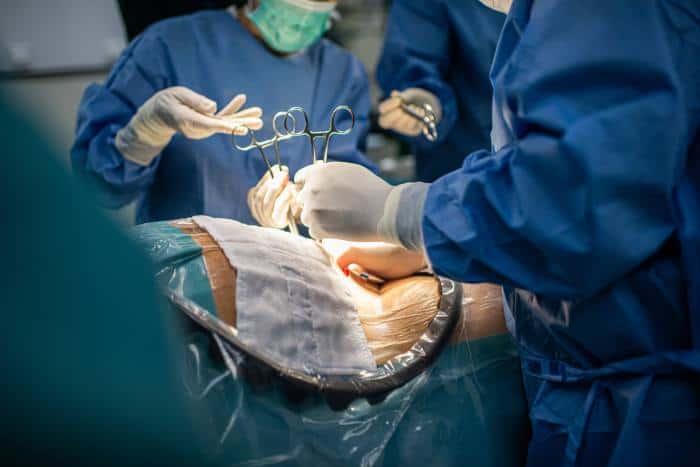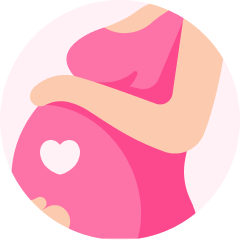A cesarean section, also known as C-section in short, is a type of surgery for delivering a baby from the mother’s uterus via her abdomen. Cesarean sections may be planned (called elective) or made as an emergency decision.

It may be recommended to address situations wherein there is
- A serious threat to the health of the child and/or mother
- Normal delivery may be difficult due to the size or position of the baby
- The mother is carrying more than one child
- Abnormal progress of labour
Cesarean sections are quite safe for the mother and the baby, although it has risks involved, as in all other types of surgeries. It takes the new mother comparatively more time to recover than in the case of vaginal birth.
When Does a Mother Need a Cesarean Section?
Cesarean section is a preferred option over vaginal delivery when there are any issues or problems that occur in the mother and/or the fetus, or when unforeseen problems arise during labour. Let’s take a look at some of the most prominent reasons behind a C-section:
Slow labor
Labour that does not progress at the expected pace is a threat to the life of the mother and the baby. This may occur when the cervix of the mother is not wide enough to support childbirth despite intense contractions over several hours. This is one of the most common reasons why gynaecologists recommend a cesarean section.
Abnormal heart rate of the foetus
The fetal heart rate during labour indicates how well the unborn fetus reacts to the contractions. The normal fetal heart rate varies between 120 and 160 beats per minute. Any fetal heart rate below or over this rate usually indicates that the fetus is in distress. The team of medical professionals evaluate the condition of the mother and baby before performing a cesarean section.
Abnormal fetal position during birth
The normal fetal position during birth is the head down while facing the mother’s back. In case the fetus is not in this position, delivery through the vaginal canal may become difficult, posing challenges to the life of the mother and the baby.

Multiple pregnancies
In case you are carrying twins and the leading baby is in an abnormal position, your doctor will most likely advise a C-section. You might also be advised to opt for cesarean delivery if you are carrying more than twins.
Prolapsed umbilical cord
If the umbilical cord passes through the cervix before your fetus, a C-section might become necessary.
Placental complications
A C-section is usually advised when the placenta bulges ahead of the fetus and into the opening of the cervix or placenta previa.
History of a Cesarean section
Women who have had a childbirth through cesarean section before may be recommended the same for the next childbirth.
You have a health concern
A cesarean delivery might be recommended in case of severe health problems. In case you have a medical condition of the brain or heart or have been diagnosed with genital herpes infection at the time of labour, you will most probably be advised to opt for a cesarean section.

What are the Risks of a Cesarean Section?
Due to the advancement in medical techniques, C-sections are generally safe. The following are the most common risks of cesarean section for a new mother:
- Urinary bladder injury
- Heavy bleeding during and post-delivery
- Blood clotting from deep vein thrombosis involves a deep vein mostly in the pelvic organs or legs. If the blood clot reaches your lungs or blocks blood flow, it can turn fatal.
- Infection in the uterus
- The surgical location/wound becomes infected
- Infection in the lining of the uterus or endometritis
- Urinary tract infection and difficulty in urinating
- Raised risk of transient tachypnea, a breathing problem that causes abnormally fast breathing during the first few hours after childbirth.
- Delayed return of normal bowel movements
- Allergic reactions to anaesthesia
- Reduced chances of a vaginal birth or VBAC during future pregnancy
- Babies born via cesarean section are also known to have lower immune systems as they are not exposed to faecal and vaginal microorganisms during birth. This puts them at risk of gut dysbiosis.
How to Prepare for a Cesarean Section?
In case you opt for a planned (elective) C-section, you will have time to prepare yourself for surgery. Below are the tips to be well-prepared for a cesarean section.
- You will be explained the procedure for cesarean delivery by your doctor.
- You will have to sign a consent form as a record of your permission to your medical team to perform a cesarean section.
- Let your doctor know well in advance if you have allergic reactions to certain medications, anaesthesia, latex, tape, and/or iodine.
- Inform your doctor about medications that you may be taking currently – prescription medications, OTC (over-the-counter) medications, supplements, vitamins, herbals, and also illicit drugs. Aspirin and anti-coagulant medications are known to increase bleeding tendencies. They will advise you on whether to stop or adjust the dosage of any medication temporarily. You may also be prescribed medications to reduce acid levels in your stomach and cease secretions from your mouth and breathing passages.
- In case of a pre-planned cesarean section that involves spinal general or epidural anaesthesia, you will most likely be advised to fast for at least eight hours before the surgery.

What Happens During a Cesarean Section?
Incision
An incision is made that extends from the skin to the uterus which is located at the lower abdomen. The incision in the skin can be either transverse (horizontal) or vertical (longitudinal).
A transverse uterine incision, which extends across the pubic hairline, is often preferred over a vertical incision. This is because the healing process is comparatively faster and is accompanied by less bleeding.
On the other hand, a vertical uterine incision extends from the navel to the pubic hairline. The type of incision that will be performed during your cesarean section surgery depends on your existing health condition and the discretion of your surgeon.
Anesthesia
A cesarean section is generally undertaken with epidural or spinal anaesthesia. In these types of anaesthesia, the effect can be felt from the waist down. You will remain in your senses throughout the c-section and will be able to see your baby being born.
Pre-op
Before the cesarean delivery starts, you will be made to wear a urinary catheter, and an intravenous (IV) line will be started into your hand/arm vein. The abdomen will be wrapped in sterile material, while a drape will be positioned over your chest for better screening of the surgical site. This will enable your anaesthesiologist to closely regulate your blood pressure, heartbeats, blood oxygen level, and breathing.
Operation
Next, a vertical or transverse incision is made over the pubic bone. An electrocautery machine will then be used to stop the bleeding.
Deeper incisions are then made through muscles and tissues on the way to the uterine wall and then another vertical or transverse incision will be made in the uterus. This will enable the surgeon to access the amniotic sac, which protectively covers the baby. The baby is then taken out, and the umbilical cord is severed. The medication that will now enable the uterus to contract is administered through the IV. This expels the placenta, which is then removed. Your surgeon will then examine the uterus for the presence of tears and search for remaining pieces of the placenta.
The incision in the muscle of the uterus will be closed with sutures and the uterus will be placed back in its original position in the pelvic cavity. Finally, the muscle, tissue layers, and skin incisions are closed with sutures. A sterile dressing or bandage will then be wrapped around the location of the suture.
What is the Recovery Period?
The healing process from cesarean section takes comparatively longer than vaginal births. Hence, women who have undergone cesarean delivery also stay at the hospital for 3 to 4 days more.
There are certain common symptoms that you may experience after a cesarean section. Some of these are:
- Itchiness and soreness in and around the location of the sutures
- Fatigue
- Constipation
- Pain in the abdomen when you cough, laugh, and sneeze
- Patient Care & Management: Post-surgical Care
- You will probably be prescribed painkillers to offer you relief from pain, keeping in mind that these are safe during breastfeeding.
Once the effects of anaesthesia have worn out, you will be advised to walk to keep yourself active, and also increase your fluid intake. This will prevent constipation and deep vein thrombosis, which are common risks of cesarean section.
In case you had a bladder catheter during your surgery, it will be removed now.
You will be encouraged to start breastfeeding as soon as you have regained enough energy for it.
Discuss with your doctor about the preventive care you should follow after being released from the hospital.
Discuss with your doctor about necessary vaccinations for the baby and make sure that they are updated.
[embed-health-tool-bmi]


















